Functionalized monomers for synthesis of rubbery polymers
a polymer and functional technology, applied in the field of rubber polymer functionalized monomers for synthesis, can solve the problems of lower rolling resistance of tires made therefrom and lower hysteresis value, and achieve the effects of improving polymer properties, low hysteresis, and good compatibility with fillers
- Summary
- Abstract
- Description
- Claims
- Application Information
AI Technical Summary
Benefits of technology
Problems solved by technology
Method used
Image
Examples
example 1
[0065] In this experiment 2-(N-hexamethyleneimino)-methyl 1,3-butadiene was synthesized utilizing the technique of this invention. In the procedure used a solution of 2,3-dibromopropane (0.1 mol) in ethyl ether was slowly added to a solution of hexamethyleneimine (0.4 mol) in an aqueous 30% sodium hydroxide solution at 60° C. The reaction mixture was stirred overnight at room temperature. The next day the organic layer was collected using a separatory funnel and extracted with diethyl ether. The organic layer was subsequently washed with water two times. After drying with sodium sulfate, the filtrate was evaporated and the resulting residue was distilled to yield 2-bromo-3-(N-hexamethyleneimino)propene. The boiling point and yield of the product were determined to be 65-68° C. at 30 mm-Hg. The yield was determined to be 60%. The molecular structure of 2-bromo-3-(N-hexamethylene-imino)propene was verified by proton NMR.
[0066] Vinyl magnesium bromide in tetrahydrofuran (THF; 0.085 mo...
example 2
[0067] The preparation of 2-(N,N-diethylamino)-methyl-1,3-butadiene is described in this example. The procedure described in Example 1 was utilized except that N,N-diethylamine was used in place of hexamethyleneimine. The yield for the intermediate product, 2-bromo-3-(N,N-diethylamino)propene was 98%. The boiling point and yield of the final product, 2-(N,N-diethylamino)-methyl-1,3-butadine was determined to be 112-114° C. at 30 mm-Hg and 50%, respectively.
examples 3-5
[0068] In these experiments 2-(N-pyrrolidino)-methyl-1,3-butadiene, 2-(N-morpholino)-methyl-1,3-butadiene, and 2-(N-piperidino)-methyl-1,3-butadiene were synthesized utilizing a procedure that is similar to the one described in Example 1 except that pyrrolidine, morpholine and piperidine were used in place of the hexamethyleneimine.
PUM
| Property | Measurement | Unit |
|---|---|---|
| temperature | aaaaa | aaaaa |
| temperature | aaaaa | aaaaa |
| temperature | aaaaa | aaaaa |
Abstract
Description
Claims
Application Information
 Login to View More
Login to View More - R&D Engineer
- R&D Manager
- IP Professional
- Industry Leading Data Capabilities
- Powerful AI technology
- Patent DNA Extraction
Browse by: Latest US Patents, China's latest patents, Technical Efficacy Thesaurus, Application Domain, Technology Topic, Popular Technical Reports.
© 2024 PatSnap. All rights reserved.Legal|Privacy policy|Modern Slavery Act Transparency Statement|Sitemap|About US| Contact US: help@patsnap.com










